Introduction
The route of the Tinners' Way along the watershed ridge of the Penwith Moors makes it key to leisure activities and exploration of a little-known landscape that contains a phenomenal number of features of interest from wildlife and ecology to archaeology and industrial heritage.
The route is crossed by several roads, from which it can be explored in stages without requiring the undertaking of the entire 14 miles in one attempt.
This guide is divided into sections based on these road crossing points.
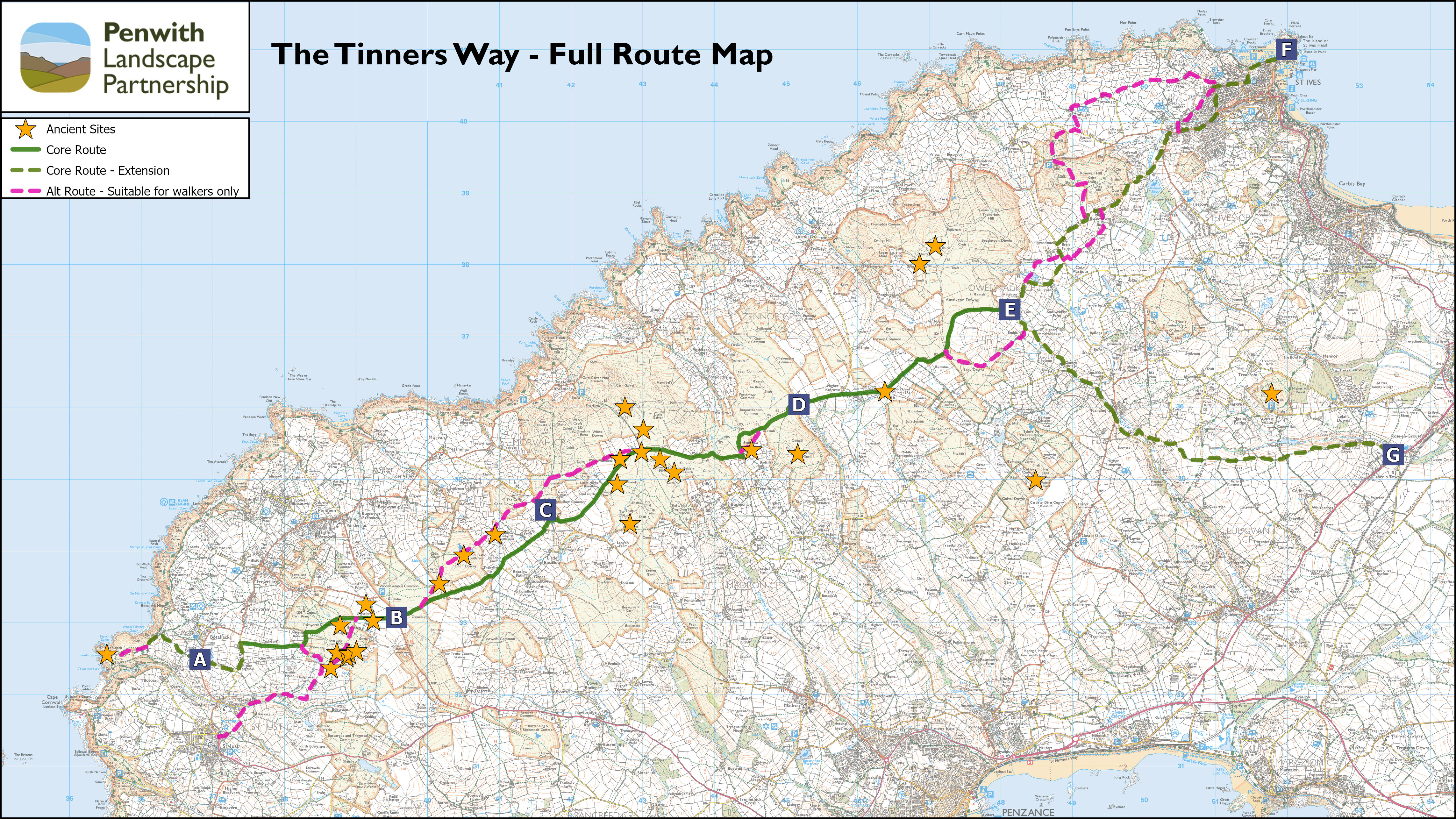
Section A: Kenidjack Castle to Woon Gumpus
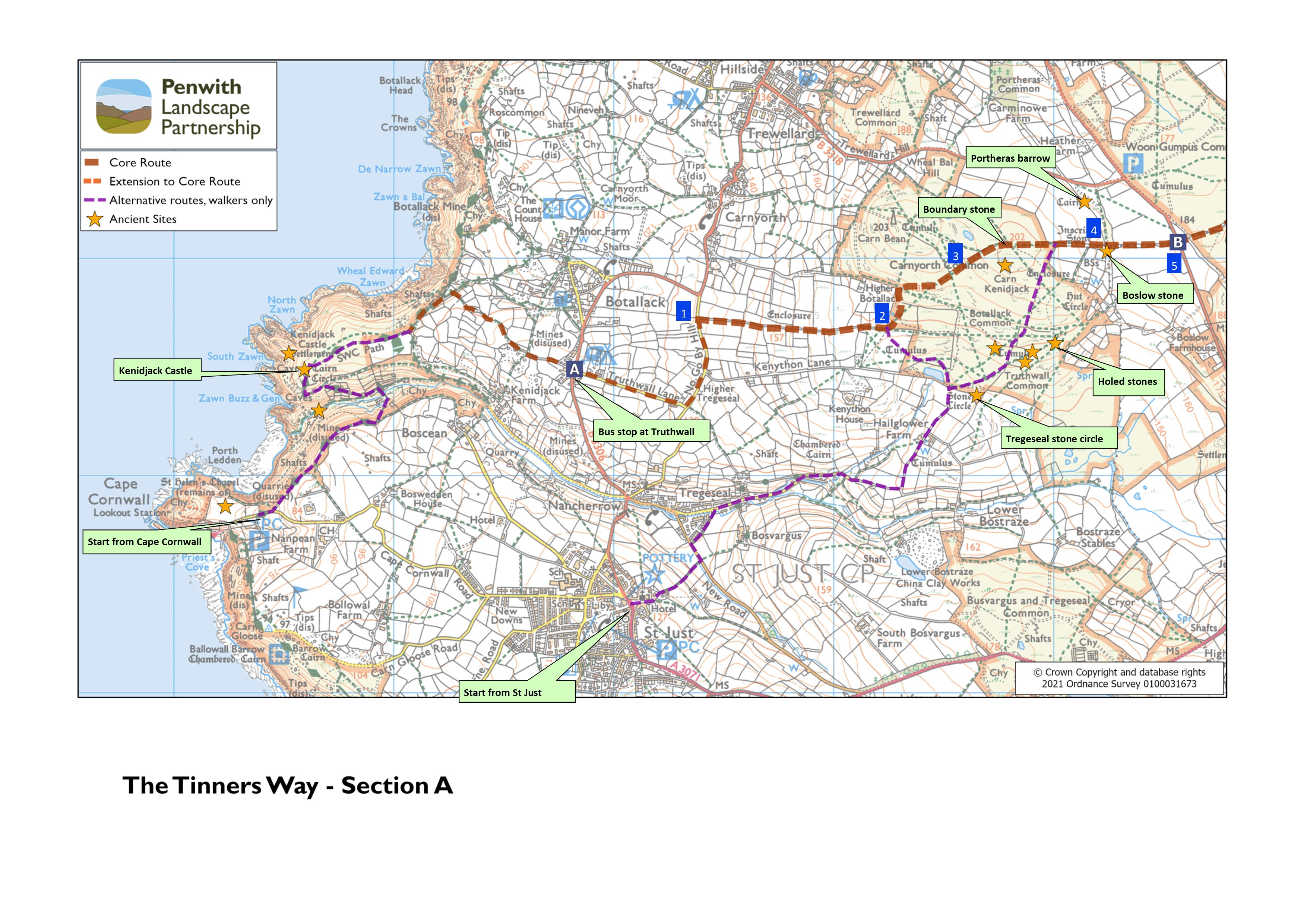
Starting options:
The extremities of the Tinners Way have been fragmented by centuries of mining, agriculture and settlement development. Kenidjack Castle can be considered the true start of the route (but requires a walk to get there). From Kenidjack Castle, you can follow the coast path east, then a bridleway inland passing Wheal Owles Count House to Truthwall (where there is a Bus Stop), straight across the B3306 and up Truthwall Lane, then left onto No-Go-By Lane, to the foot of Devil’s Lane. To reach Kenidjack Castle, you could start the route at Cape Cornwall (on foot), following the coast path down into Kenidjack Valley then up onto the headland on which Kenidjack Castle sits, then on to Truthwall from there.
Alternatively, you could start from St Just (for public transport links and parking), walking down into the Tregeseal Valley, then up onto the moor via Hailglower Farm. This option takes you right past the Tregeseal Stone Circle, Barrows and Holed Stones. See our Trail Guide for this area here.
1. |
Devil’s Lane marks the proper starting point to the Tinners Way as it still exists today. It’s entrance is near the northern end of No-Go-By Lane, about one hundred metres south of the junction with the B3306. Follow this hedged lane all the way to the top. |
This is the central one of three parallel lanes heading uphill onto Carnyorth Common. Devil’s Lane is clearly ancient; it is a “green lane” or a hollow way, quite narrow in parts. The name links with legends of the moor it leads to, where the devil on horseback is said to hunt lost souls at night. |
|
2. |
From the top end of Devil’s Lane, the route turns left as a recognizable path uphill. It then meets another path leading west to east – turn right onto this track and continue to the brow of the hill, just west of Carn Kenidjack. |
Towards the top, a linear bank, part of a post-medieval enclosure, defines the left-hand side of this section of track. |
|
3. |
On the brow of the hill another track crosses the way, and by this junction there is an old manorial boundary stone. The trackway heads down off the moor and into a wide hedged lane, passing close to Higher Boslow Farm. |
Carn Kenidjack is also known as the Hooting Cairn... From the top of Carn Kenidjack you can see the line of the Tinners' Way continuing east off Carnyorth Common and across to Woon Gumpus. |
|
4. |
Past Boslow Farm, the route is crossed by another trackway leading from north to south; on the southern side of this ancient crossroads stands the Boslow Inscribed Stone. Continue straight ahead, eastwards towards the B3318. This bit of hedged lane is known as “Watery Lane”. Just as the name and flat topography around it would suggest, parts of it are frequently filled with standing water. Take caution when reaching the main road at the eastern end of the lane. |
The Boslow Inscribed Stone, still in its original setting, is dated to 7th century AD. It marks the grave of a man believed to have been a priest; the Celtic name on the stone is TAETVERA, thought to be a name “taken in religion”, translates as “exalter of the journey”. More information here. There is another manorial boundary stone a little way along Watery Lane on your left. |
|
5. |
Cross the main road, onto the continuation of the track the other side. Running along the southern edge of Woon Gumpus (The Gump), this is a wide, open track with earth and gravel surface, hedged on its southern side but largely open to the moorland on the northern side. |
Woon Gumpus public car park is a short way to the north from here. See our Trail Guide for this area here. |
Section B: Woon Gumpus to Bosullow Common
SPLIT ROUTE
At Pella Corner, the original trackway divides into two parallel routes for a distance of two miles before reuniting near the Four Parishes Stone (on Section C map). The higher, northern route contains a few stiles and a section of permissive footpath, and so is only suitable on foot. Equestrian and cycle use is therefore restricted to the southern route as far the road at Bosullow Common. Both routes have sections of ancient, hedged lanes. The north and south routes will now be considered individually. See our Trail Guide for this area here
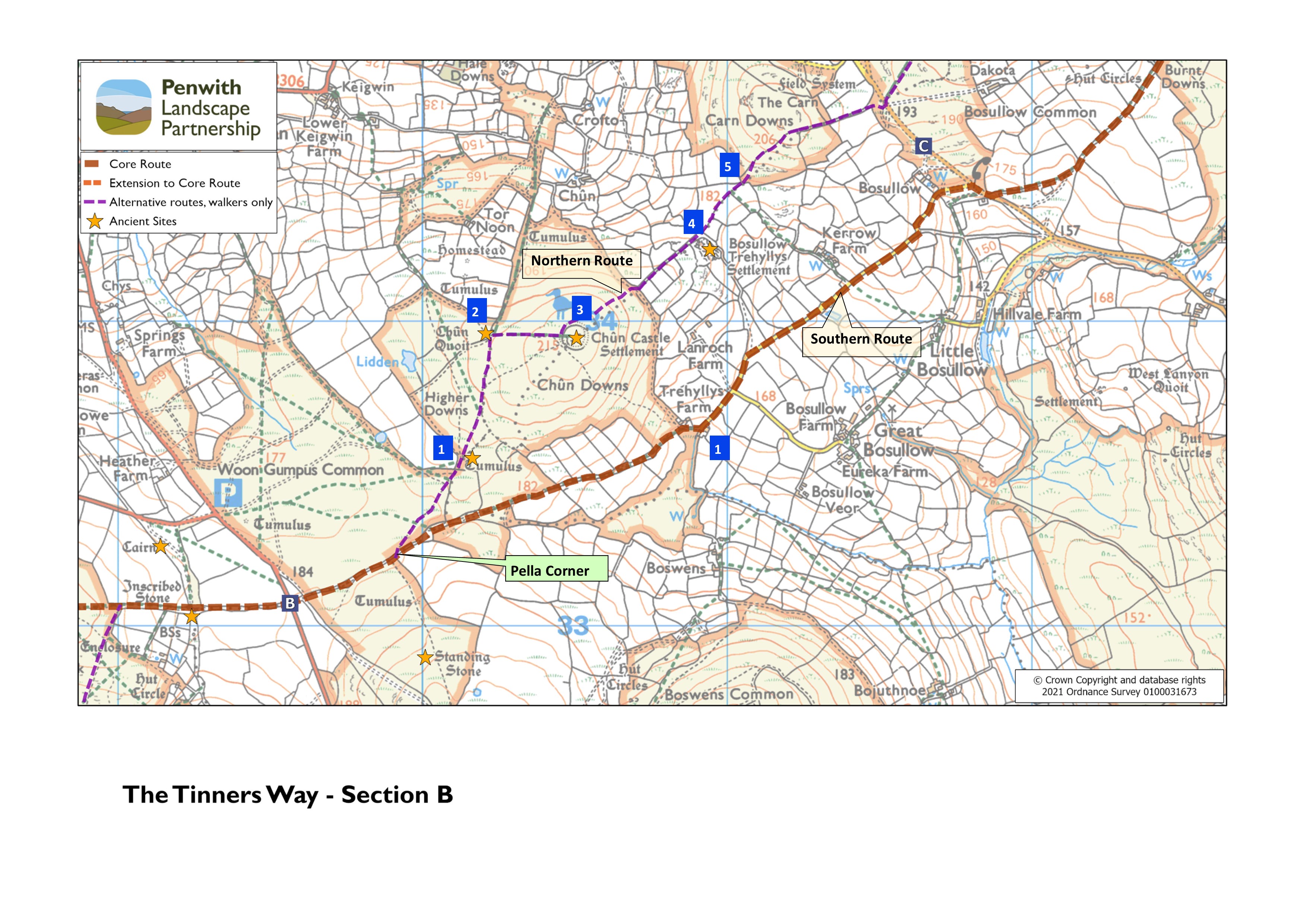 NORTHERN ROUTE
NORTHERN ROUTE
1. |
From Pella Corner the path leads north-eastward from the track, passing by a prominent Bronze Age barrow, and climbs steadily northwards towards Chûn Quoit. |
Note that the original track continued north-eastward to the Castle on a more direct line; this can still be faintly seen on aerial photography but is lost on the ground under the gorse and heather. |
|
2. |
At Chûn Quoit, turn right and carry on to the summit of the hill and Chûn Castle. |
Chûn Quoit is one of the best surviving examples of these Neolithic structures in Penwith. Click here to go to CASPN's page for more information. |
|
3. |
When you reach the outer rampart of the castle, look for a path heading off to the left beside the rampart, round to the other side of the castle. This path then continues downhill, heading for the opening of an old hedged lane leading away from the base of Chûn hill. |
Chûn Castle is an impressive Iron-Age hillfort. Surrounded by two extensive stone walls, the interior of the site contains the remains of several roundhouses. The hillfort has previously been excavated, showing a period of occupation from approximately the 3rd Century BCE to the 1st Century CE. |
|
4. |
This lane runs past the Iron Age settlement of Bosullow Trehyllys. Beyond the settlement, the route crosses a stile, continuing along the saddle between the two hills of Chûn and Carn Downs. |
Bosullow Trehyllys is a Romano-British courtyard house settlement. The lane adjoining it is thought to be contemporary with the site. Note there is no open public access into Bosullow Trehyllys settlement. However, visits of the site can be arranged directly with the landowner Miss Jackie Boynes. She is very happy for people to phone up for permission, and encourages those that do so to spend as long as possible on the site to make the most of their visit. You are best able to reach her around 9pm each evening, on 01736 788795. If you're just passing by and can't pre-arrange a visit, you are still able to see a very good portion of the site from the lane. |
|
5. |
Cross a stile at the far end of the field, then follow rough path straight ahead, up and over The Carn. On the other side, the path leads into another section of hedged lane, coming out onto the Madron - Morvah road at Bosullow. |
The Morvah Hoard was found in 1884. Consisting of 6 exquisite Bronze Age bracelets now to be found in the British Museum. Take a look here -https://britishmuseum.withgoogle.com/object/the-morvah-hoard |
SOUTHERN ROUTE
1. |
From Pella Corner, continuing straight along the built stony track across the southern edge of Woon Gumpus Common, and then down off the moor to Trehyllys Farm |
Trehyllys in its present form resembles tre ‘farm, settlement’ + henlys ‘old ruin, but is in fact a corruption of crellas ‘courtyard houses’ (the nearby ancient village being Bosullow Crellas in the 19th century.) (Akademi Kernewek) |
|
2. |
Past Trehyllys Farm, the route follows the public road out to the Madron - Morvah Road at Bosullow |
Despite now being a road, it is clearly an ancient routeway; bordered by old hedges, very winding and narrow in parts. |
Section C: Bosullow Common to Trye Valley
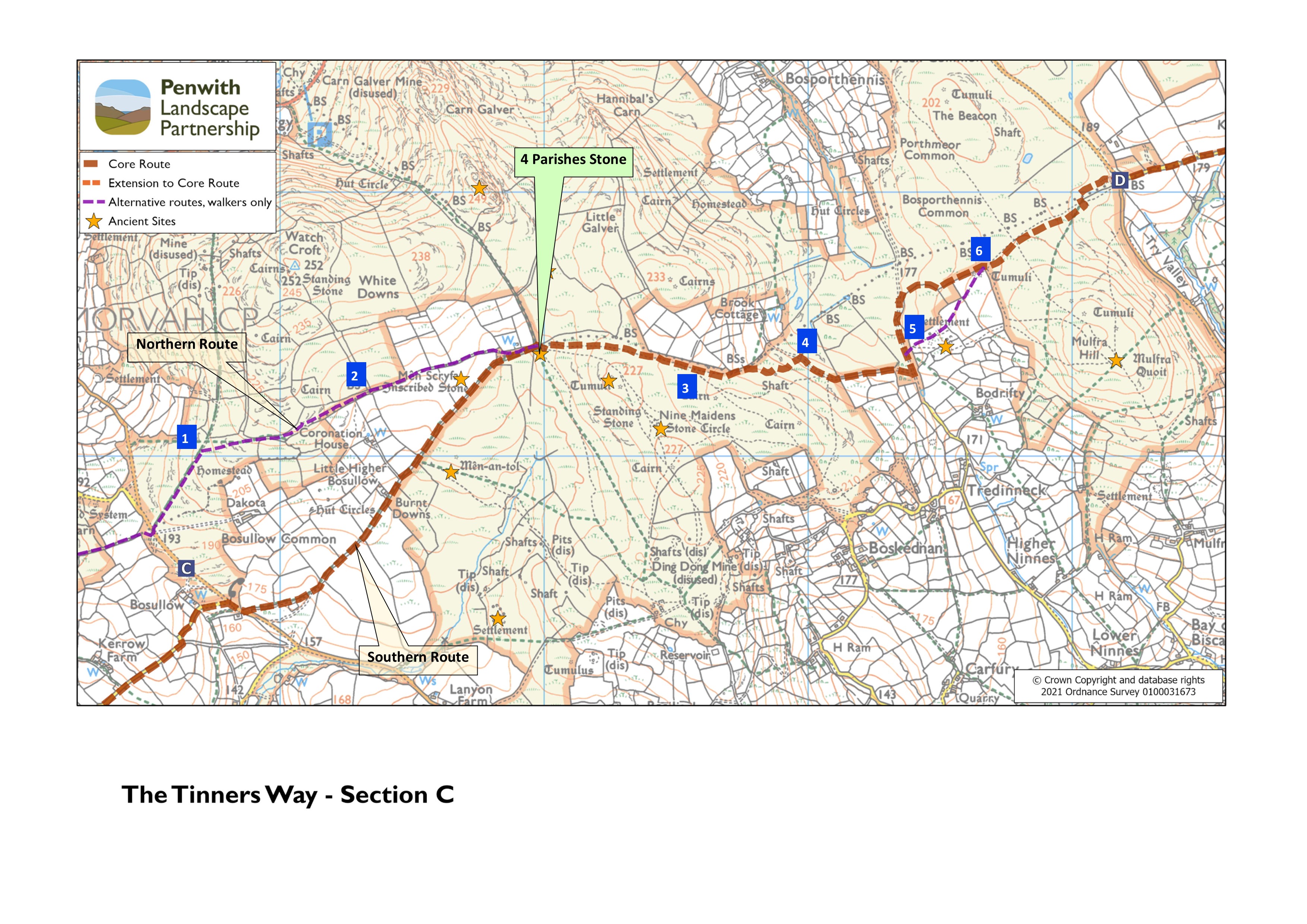 NORTHERN ROUTE
NORTHERN ROUTE
1. |
The route now follows the built track on the opposite side of the road. This is a public bridleway and the access track to Garden Mine Cottage, the property high up on the western side of Watch Croft. Just before the track starts to bend to the left, look for a footpath branching off to the right, and follow that. |
Watch Croft is the highest point in Penwith. It is classed as a 'Marilyn' because it exceeds 738 ft (225 metres). There are only four other 'Marilyns' in Cornwall - Brown Willy, Hensbarrow Beacon, Kit Hill and Carnmenellis. Views open out to Pendeen Watch and the north coast. This bit of path across the moorland is uneven and rocky in parts, take care. |
|
2. |
The path ahead from this point is obvious to follow, as it contours along the southern slopes of Watch Croft before leading into another section of hedged lane running along the bottom of White Downs. At the end of this lane, the track converges with the southern route at the Four Parishes Stone
|
White Downs The last field between the two lanes before they converge, contains the Men Scryfa. This 1.8m (6ft) tall standing stone probably dates originally from the Bronze Age, but was re-used in the late Iron Age/Celtic period (5th or 6th century AD) when an inscription was carved along the northern face of the stone. This read RIALOBRANI CVNOVALI FILI, (the FILI is now below ground) which is a Latinised form of Cornish, and means ‘Royal Raven, son of the famous leader’. More information here
|
SOUTHERN ROUTE
COMBINED ROUTE
3. |
Heading east from the Four Parishes Stone, the paths diverge – the route takes the left-hand path and climbs steadily Onto Nine Maidens Common – The Tinners Way runs along the northern boundary of the common, passing close to a number of boundary stones. The path levels out then descends to join the track that leads to Brook Cottage. |
The Four Parishes Stone, or Men Crows (men, "stone" + crows, "cross") is an elongated natural boulder with a small incised cross, which marked the meeting point of the four ecclesiastical parishes of Zennor, Morvah, Madron and Gulval. For much of this section there are ruts or gullies caused by footfall and water scouring, but there is a clear use line avoiding the ruts Venton Bebibell (Little People's Well) can be found 150 metres along a little used path leading south from Four Parishes Stone at Grid Ref: SW 429352. This sacred spring and source of the Newlyn River, is still visited on Good Fridays by children to bless their dolls. The Nine Maidens stone circle can be seen on the horizon to the south. More information about this Bronze Age feature can be found here |
|
4. |
Upon joining the track, turn right and continue downhill into another section of (recently resurfaced) ancient hedged lane. At the bottom, the track opens out then joins the track from Tredinnick to Bosporthennis. Turn left onto this track; the Bodrifty Settlement is now just ahead on your right. |
Brook Cottage, among the most remote locations in Penwith. | |
5. |
Route splits for a short way at the Bodrifty Settlement. Walkers can follow the permissive path through the settlement and back onto the moor; all users can follow the track north a little way, then turn right onto the Public Bridleway, initially skirting the enclosed fields to the south, then reaching open moorland towards the top.
|
Bodrifty Iron Age Settlement - more information here | |
6. |
Follow the path straight ahead over the moor and down towards the road the other side. Ahead you now have clear views of the Zennor Hills and Castle an Dinas. Reach Gear Hill (road from Penzance to Treen) at the top of the Trye Valley |
This part of the moor is striped with countless old track lines that have fallen in and out of use, as the lines erode. Keep an eye out for the Parish boundary stones running in a line just north of the current line of the track. Several paths off to the right lead uphill to Mulfra Quoit. |
Section D: Trye Valley to Embla Vean

1. |
The route follows the road signposted to Zennor and St Ives from the junction, just to your right. |
|
|
2. |
Carry straight onto the gravelled track - as the road sharply bends left at Higher Kerrowe Farm - known as "Ladydowns Lane."
|
||
3. |
The first (and only) bend you come to on this stretch of track is the site of “Bishop’s Head and Foot”…. Beyond Milldowns Cottage the track opens out into a wide hedged lane, then into wide open moorland. |
The parish boundary marker at Bishop’s Head and Foot is marked by a square slab. A gate on the right here gives access to Carnaquidden Downs. |
|
4. |
Out onto the moors the track ahead is well used and usually obvious and all recorded as a Public Bridleway. The route heads E then NE around the edge of the open moorland
|
Once on the open moorland there are views across to Zennor, Sperris and Trendrine | |
5. |
Junction – waymarked – take the right hand fork towards Embla Vean, initially N then NNE, with views back from here towards Green Burrow and down the valley to Zennor. The left hand fork goes north along the old drove road leading to Zennor Quoit. |
Lady Downs, Amalveor Downs. Note: if you are heading to Rose an Grouse, not St Ives, you can turn off to the right at Lady Downs and follow a footpath down the hill joining the road a little further south - purple dots on the map. |
|
6. |
Eventually, around the top of Amalveor Downs, the track runs into another hedged lane – which starts sloping gradually down but gets steeper as it descends to Embla Vean. |
This lane is known as Badgers Lane. |
This concludes the 'core' of the Tinners' Way as it passes over the moors. From this point at least two continuing routes can be followed, to St Ives or Rose-an-Grouse.
Section E: Embla Vean to St Ives (staying off the roads as much as possible - purple dotted line!)
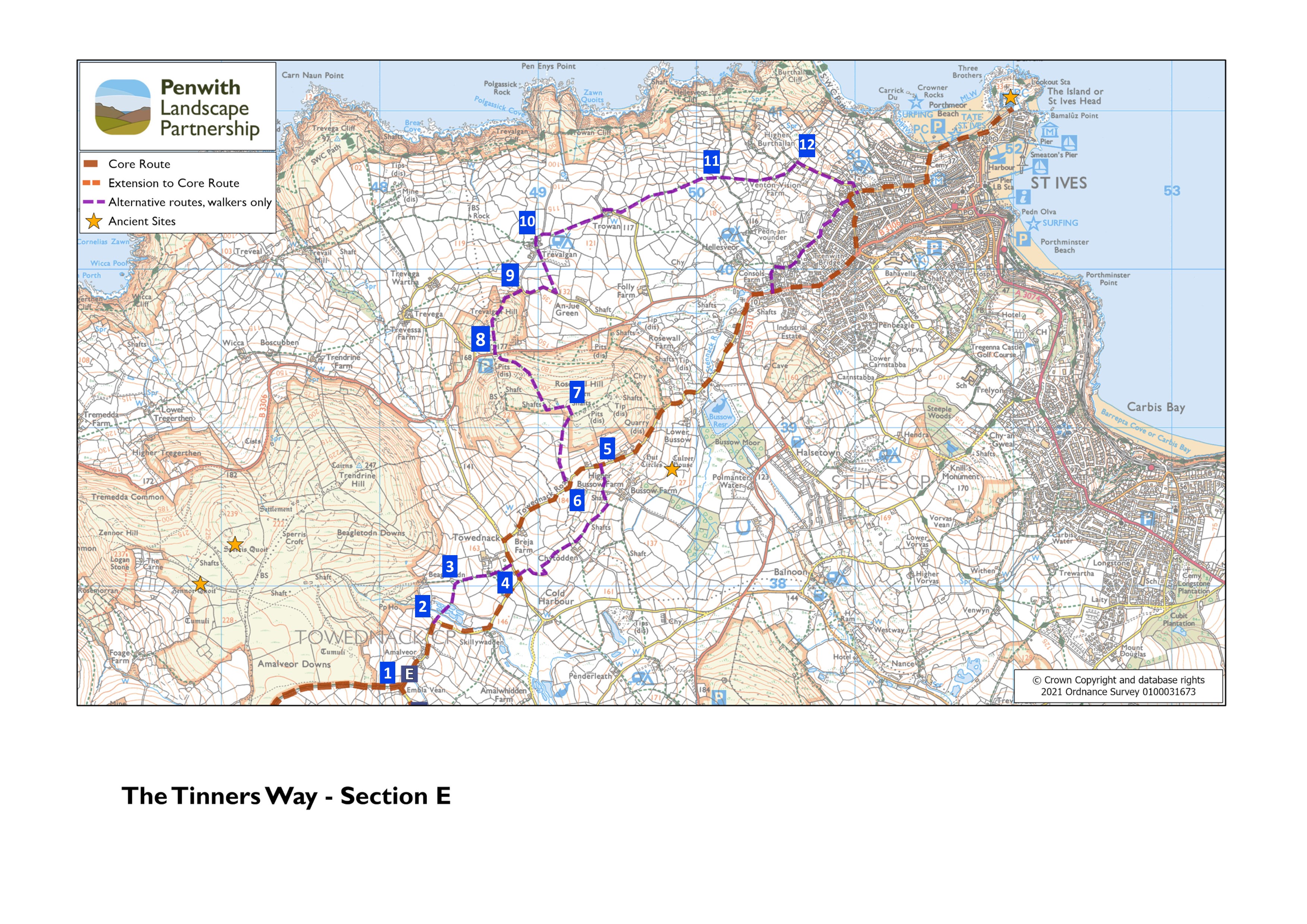
1. |
The footpath reaches the road at SW48143738. Turn left and walk along the road for about 500 metres, passing Amalveor Farm. |
In1931, a collection of beautiful gold objects, known as the Towednack Hoard was found at Amalveor Farm concealed in an ancient stone hedge. It included two twisted neck rings, four arm rings and two lengths of unfinished gold rod. The gold was very fine, and probably came from Ireland. The items were dated as middle Bronze Age – about 1000BC, were declared to be treasure trove, and are now in the British Museum. Copies of the finds can be seen in the Royal Cornwall Museum in Truro. This find served to illustrate the immense age of some of Penwith’s stone hedges and points to the virtual certainty that the Tinners’ Way was a well-established trade route at that time. |
|
2. |
Leave the road where it turns sharp right at SW 4835 3779 and take the (unsignposted) path straight ahead. The path passes between the pools of Sweet Water Trout Farm and briefly joins the drive that leads to Sweet Water farmhouse before passing through a gap in a stand of bamboo and over a stile to the field beyond. Keep to the left of the hedge until near the top of the field where the path bears right through a gap in the hedge at SW 4848 3801. |
|
|
3. |
Join the path at SW 4850 3803. The path heads east keeping to the right of the hedge as far as Towednack church - watch out for blackthorn! The path joins the access road for Towednack church and reaches Holmans Moor Road. Note that people are welcome to use the car park at Towednack church; a voluntary donation is requested. |
An old legend accounts for the low church tower. It is said that every night the Devil would tear down all the work that masons had done during the day, so that in the end the masons simply gave up and left the tower at its present height. |
|
4. |
Turn right when you reach the road then, just past the cottage, turn left back onto the footpath. When you enter the next field, follow the field boundary around to the right. Enter the next field and follow the path past Chytodden Farm, cross some ancient stone 'coffen' stiles |
|
|
5. |
Go through a field gate and head along the path to the left of a ruined engine house, joining the access track from Higher Bussow Farm. At the end of this track turn left and continue on Towednack Road for about 200 metres. |
|
|
6. |
Turn back onto the footpath. |
|
|
7. |
Here the paths forks, take the left hand fork and follow the path (there may be others) to lead you along and over the saddle between the 2 peaks of Rosewall Hill, through a couple of kissing gates - heading down to the car park. |
Rosewall Hill (National Trust) has many ruins of mine associated buildings including stamps, stacks and engine houses. Magnificent views from up here to Zennor and St. Ives |
|
8. |
Cross the road and take the well defined path up, and down, Trevalgan Hill to join the road |
On the descent the path passes a prominent rock carrying a memorial to the artist Peter Lanyon, whose work drew inspiration from the West Penwith landscape. |
|
9. |
Take the path signposted to Trevalgan Touring Park, follow the access road between the buildings, leaving the road at a clearly marked stile. (NB The OS map shows a different route, but recently that path has been impassable across a potato field). |
|
|
10. |
The footpath joins another footpath that skirts the buildings on the N side. Turn right onto this footpath. The path passes through two more fields, crossing over stiles in the hedges, to reach Trowan. At this point the path continues through Trowan, passing between the houses, instead of skirting the hamlet on the N side as shown on the OS map. (The official Orders to change the route have not, as yet, been confirmed.) |
Trowan was a 700 year old tiny 'forgotten' hamlet until bought up, lock stock and barrel in the 2010s and all the buildings upgraded. Now mainly holiday cottages. |
|
11. |
The route crosses a track - probably the way to Hor Point copper mine on Hellesveor Cliff to the north. There are many ancient stiles along the route to Higher Burthallan |
|
|
12. |
Take Burthallan Lane to your right. When you reach Alexander Road turn left and follow your nose into the middle of St. Ives. |
In St.Ives Museum (Wheal Dream, St Ives, Cornwall, UK, TR26 1PR) you can find out more about the history of St.Ives including it's links with mining, fishing, art and tourism. |
Section F: Embla Vean to Rose-an-Grouse

1.2.3.4.5.
6. |
The route turns right here, down the road for 2km (turning right at the T junction) to reach Nancledra. In Nancledra, turn right at the main road (B3311) walk up the pavement and cross over into the smaller road that follows the Red River. Take the first left up the hill, across the Red River and carry on following the road round until you find a green lane on your right. Take this (unmarked) lane (Grid Ref. SW504355). This beautiful lane is used by horses and will be muddy underfoot at certain times of the year. Here you cross another ancient trackway - St. Michael's Way.
The lane eventually emerges on to to hard surface of Heather Lane, through the houses of Gorran and onto the busy A30. 200 metres to the left and on the other side of the road is the site of the old Rose-an-Grouse smelting house.
|
St Michael’s Way is a one-day coast-to-coast Micro-Pilgrimage in Cornwall. It follows the north-south line between West Penwith and the rest of the world. The route was created after the discovery of ancient shipping rosters proving that pilgrims historically came to Lelant by sea on their way to Santiago de Compostela, and travelled over land to Marazion to avoid the waters of Lands End. St Michael’s Way is the only pilgrimage route in Britain that is officially part of a European Cultural Route. It is a genuine British leg of the Camino to Santiago!
The Rose-an-Grouse smelting house was adjacent to the Lamb and Flag public house (now a residential property) and operated from 1715 to 1883. From here some Penwith tin was subsequently transported to Hayle Harbour for shipping to Wales and points further northward.
|



